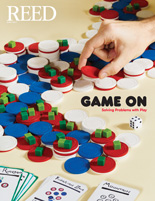
IRIS login | Reed College home Volume 96, No. 2: June 2017
Guesswork and the Rankings Game
U.S. News & World Report released the 30th annual edition of its influential “best colleges” rankings yesterday. You’ll find the usual suspects at the top of the list. Reed came in at the weirdly low Number 77.
To me, however, the biggest surprise was St. John’s College.
St. John’s, if you’re not familiar with it, is a wonderful college in Annapolis, Maryland. Founded in 1696, it boasts an incredible 8-1 student-faculty ratio and a “Great Books” curriculum that makes me drool.
This year, it catapulted from Number 123 to Number 56 in the U.S. News rankings. Remarkably, St. John’s did not achieve this feat by hiring a raft of new professors or recruiting busloads of freshmen with killer SATs.
It just sent back a survey.
Back in the mid-nineties, Reed and a handful of other liberal arts colleges, including St. John’s, pulled out of the US News rankings because of concerns that the enterprise was deeply flawed and vulnerable to manipulation. US News continued to rank the holdouts anyway—possibly fearing that if it didn’t, more schools would bolt.
For almost 20 years, Reed and the holdouts have been relegated to the middle of the pack, although U.S. News has always denied any element of retaliation.
But St. John’s meteoric rise has to make you wonder. Was the school’s score all these years artificially depressed by its refusal to play the rankings game?
It’s worth noting, by the way, that St. John’s president, Christopher B. Nelson, remains a prominent critic of the U.S. News system, despite his school’s sudden reversal of fortune. “It should suggest something about the unreliability of the rankings, frankly,” Nelson told the Washington Post.
I doubt that St, John’s has changed very much over the last couple of years. My hunch is that U.S. News was using estimates, not data, to calculate St. John’s score—and that the estimates were weirdly low.
Funny, that.



LATEST COMMENTS
steve-jobs-1976 I knew Steve Jobs when he was on the second floor of Quincy. (Fall...
Utnapishtim - 2 weeks ago
Prof. Mason Drukman [political science 1964–70] This is gold, pure gold. God bless, Prof. Drukman.
puredog - 1 month ago
virginia-davis-1965 Such a good friend & compatriot in the day of Satyricon...
czarchasm - 4 months ago
John Peara Baba 1990 John died of a broken heart from losing his mom and then his...
kodachrome - 7 months ago
Carol Sawyer 1962 Who wrote this obit? I'm writing something about Carol Sawyer...
MsLaurie Pepper - 8 months ago
William W. Wissman MAT 1969 ...and THREE sisters. Sabra, the oldest, Mary, the middle, and...
riclf - 10 months ago